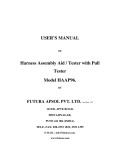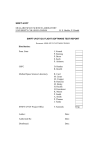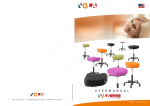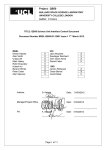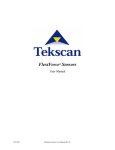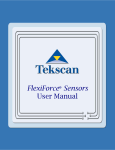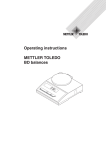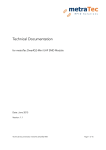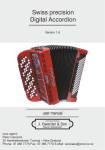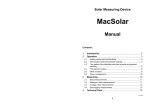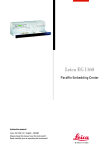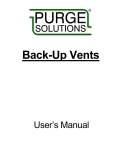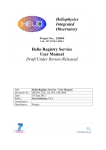Download USER`S MANUAL One To One Continuity Tester with Parts Counter
Transcript
USER’S MANUAL OF One To One Continuity Tester with Parts Counter Model CT121-48(96) VER 1_7, manual date 24/10/07 BY FUTURA APSOL PVT. LTD. 5 & 6, B wing, Mangalmurti Complex, 117/A, Sinhagad Road, PUNE 411 030. TELE- FAX: 020-2425 1128 E-MAIL : [email protected]. www.futuras.com One To One Continuity Tester with Parts Counter Model CT121-48(96). Packing List 1. One To One Continuity Tester 1 no. 2. This User’s Manual 1 no. 3. Mains cord 1 no. similar to PC mains cord. 4. Cable from tester to board / rig as per number of points or connectors. 5. Cable for parts counter probe. Important Note : Preserve the packing sent along with the tester which is specially designed for protection of the tester during transportation. In case tester is to be sent back to Futura, use the same packing. INDEX GENERAL PRECAUTIONS. 1 : INTRODUCTION 1.1 : Function 1.2 : Specifications. 2 : DESCRIPTION OF MENUS : 2.1 : Test : 2.1.1 : All Circuits 2.1.2 : Circuit by Circuit. 2.1.3 : Parts Counter. 2.2 : Setup: 3 : OPERATION : 3.1 : Front and Back panels: 3.2 : Display meanings and keys used: 4 : POINTS TO REMEMBER : 5 : ONE TO ONE CONTINUITY CHECKER CONNECTIONS TO RIG / FIXTURE / BOARD. 6 : OUR OTHER PRODUCTS AND SERVICES. GENERAL PRECAUTIONS. Before using the equipment read the following carefully. Following points are to be taken care of while using the equipment. These will protect the equipment from malfunction and any damage. # Any external continuity meter like buzzer, bulb or multimeter should be strictly avoided. Use of these will damage the internal electronic delicate components. # The tester is designed to work for 230V AC with ± 10% of fluctuation. If the voltage goes below the specified voltage; the tester will not work as expected. It is advisable to have a voltage stabilizer preferably a CVT. # While changing the board; removal and fitting of D type connectors on the back side of the tester or centronics connector on the board, should be done with utmost care. These connectors are polarised and hence should not be inserted in wrong direction. There is a tendency to push the connector hard in the tester even if polarisation is incorrect. Pushing might damage the connectors on I/O cards or on the board of the tester. # The tester has a long life and does not need much of maintenance if used carefully. The maintenance is required for the rig or mounting board. # Check proper earthing at the power supply input of the Cable Harness Tester. Warrenty void if equipment is opened by unauthorized person. 1 : INTRODUCTION : 1.1 : Function : One to One continuity tester is to test one to one continuity of a circuit. Application can be a fixture with limit switches, a connector or a coupler with open ends. It does not check midjoints. Tester can test for maximum of 48 (96) circuits/cables. Last circuit to be tested is user programmable. Set up allows programming of last circuit, harness name to be stored in EEPROM using PC key board. Last circuit can be stored for 25 different harnesses. Futura’s one to one tester also has parts counter to count parts on a harness using a limit switch probe. Number of parts are programmable for 25 different harnesses along with harness name. Maximum parts counted are 99. It is a microcontroller based tester. 1.2 : Technical Specifications : Power Supply : 230V ac +/- 10% AND or OR +12 V DC (-4 V DC, +2V DC, Ripple < 1%), 800 milli Ampere. One to one continuity tester : Number of circuits to be tested : 48 (96) circuits i.e. 96 (192) points. Last circuit to be tested, programmable by user. Refer document for circuit connections. Test Voltage : TTL Logic 1 level @ 5V DC. Test Current : In milliamperes. Tester I/Os : 37 pin D F connectors, 3 (6) nos. terminated at back side of tester. Parts Counter : Maximum number of parts counted : 99 (Ninety Nine). Input : A probe with limit switch using 9 pin D type ‘F’ connector at pin numbers 1 and 2. General User input : 4 key touch pad sealed, keyboard viz. Enter, Up, Down, Escape. Facility to connect PC keyboard for entering component name. User output : 16×1 LCD display with backlit. Buzzer audio output on Pass. Relay no potential contact rating 230V, 5 A on Pass. A 5mm Green LED on Pass. User Interface / functional specifications. Keys Enter : Accept command or menu. Up : Next command in menu or increment number. Down : Previous command in menu or decrement number. Escape : escape to previous menu or escape from test. Menus and submenus : (Menu name and keys accepted) Start Test? : up / down / Enter. Setup? : up /down / enter. Change Component ? : up / down / enter/Escape. Change cable number Change data ? : up / down / enter/Escape. Change last circuit. Change test mode? : up / down / enter / Escape. All Circuits : up / down / enter / Escape. Ckt by ckt : up / down / enter / Escape. Parts Counter : up / down / enter / Escape. Name Component? : up / down / enter / Escape. PC Keyboard entry : To accept Enter on Keyboard. 2 : Description of menus : 2.1 : Start Test : Starts testing in selected test mode for selected component number. 2.1.1 : All Circuits : Testing of continuity from circuit 1 upto last circuit for the selected component number. Passed only if ALL CIRCUITS are found correct in one pass. Finds out and displays, open and short faults. Keeps displaying first fault located. On every pass, counter is incremented. After passing, displays “Remove Component” and after removing, displays “Mount Component”. Starts testing, even if one circuit found connected. After displaying error, any key will not be accepted and faulty harness will have to be removed. Fault display will be “ Open xx” meaning open circuit number xx, “short xx with yy” meaning shorted circuit numbers xx and yy. 2.1.2 : Ckt by Ckt : Testing of continuity from circuit 1 upto last circuit for the selected component number. Checks each point and considers correctness of each point even if continuity is found momentorily. Checking is not done sequentially. Passes if all points are found correct. Finds out and displays open faults. Keeps displaying first fault located. On every pass counter is incremented. After passing displays “Remove Component” and after removing, displays “Mount Component:. Starts testing even if one circuit found connected. After displaying error, no key will be accepted and faulty harness will have to be removed. “ Open xx” meaning open circuit number xx. Since tester displays “Mount Component” if all circuits are found open, here care should be taken that at least one fixture should be of locking type and will be locked throughout testing. Hence Testing will start after mounting component in this fixture and “Mount Component” display will appear after removing component from this fixture. 2.1.3 : Parts Counter : It counts parts on shorting pin numbers 1 and 2 of 9 pin D type connector provided at the back side. When all parts are counted any key pressed will indicate that counting is complete. Count will be compared with stored count and pass will be displayed if matched, else “Count Error” will be displayed for @3 seconds and will start counting again. To end testing, ‘Escape’ is to be pressed again when error is displayed. Required count is programmed for 25 components along with component name. Test mode will end with Escape key. 2.2 : Setup: In ‘Change Component’ mode, set up facilitates selecting component number out of 25 nos. Keys ‘up’ and ‘down’ will change component number and ‘enter’ will accept displayed numbers.. In ‘Change Data’ mode, set up facilitates changing last circuit (number of parts for parts counter) For continuity checking and parts counter same database is provided in EEPROM. Keys ‘up’ and ‘down’ will change last circuit number display and ‘enter’ will accept displayed numbers. In ‘Change Test Mode’ mode, setup facilitates selecting test mode from ‘All Circuits’, ‘Ckt by Ckt’ and ‘Parts Counter’. Keys ‘up’ and ‘down’ will change modes display and ‘enter’ will accept displayed mode. In ‘Name Component’, setup facilitates entering name of a component. Blinking cursor will be at the first position of component name. Alphanumeric name can be entered if PC-AT keyboard is connected. Maximum number of characters in a name can be 10 numbers. Enter key on keyboard will save the name. Any key on keyboard will come out of setup mode without saving. PC Keyboard connector. LCD Display PASS LED Indicator FUTURA FUTURA---VER 1_7 ENTER ESC Buzzer speaker 4 keys sealed keyboard. Power On switch and input socket + fuse and SPARE FUSE. CKTs 81 - 96 CKTs 65 - 80 FUSE Parts counter probe CKTs 49 - 64 Relay TONE CKTs 33 - 48 VOL CKTs 17 - 32 CKTs 1 - 16 +12 V 37 pin D type F connectors for CKTs GND - 12V, External 12 V DC supply terminals and use gnd terminal for board Futura Apsol Pvt. Ltd., Pune, India. Continuity Tester : One to One, CT121 Front and Back panel details. Drawn by GSR on 14/6/2001. Doc No CT121 PD. (drawing not to scale) output P,NC,NO 3 : Operation : 3.1 : Front and Back panels: Front Panel : 4 keys keyboard, 16*1 LCD display with backlit and PC keyboard socket. Back Panel : Mains input socket with fuse and spare fuse, Mains power on switch, Relay output terminal strip, 9 pin D type connector for parts counter probe, +12 V DC , 800 milliAmpere alternate power input, Tone and volume control of buzzer. Connect power cord, provided with tester, which is similar to PC mains cord, to the tester at socket provided on the back panel. Switch on power using power on switch. Tester displays “FUTURA VER*****” for @ 2 seconds, last selected test mode for @3 seconds, last selected component number and its data for @5 seconds and “START TEST?”. Use keyboard on front panel for further functions as required. Refer to section 3.2 for display meanings and keys to be used. Relay : Relay will be normally off and will be on for @3 seconds on Pass. Relay output is provided on back side on a terminal strip. Pole, NO and NC are all available for use. Parts counter probe is to be connected to connector provided with tester. +12 V DC also can be used to supply power to tester. Input is using terminals on back panel. Open wire or multimeter probes can be used for input. 3.2 : Displayed messages, their meanings and keys to be used. : START TEST? : Start Testing? : ‘Enter’ starts testing, ‘up / down’ next menu, ‘Escape’ no change. SETUP? : Want to change settings? : ‘Enter’ displays “CHANGE TESTMODE?”, ‘up / down’ next menu, ‘Escape’ to “SETUP?”. CHANGE COMPONENT ? : Want to change selected component? : ‘Enter’ displays currently selected component and its data. ‘up / down’ next menu, ‘Escape’ to “SETUP?” CHANGE DATA ? : Want to change selected component’s data? ( last circuit) : ‘Enter’ displays currently selected component and its data. ‘up / down’ next menu, ‘Escape’ to “SETUP?” CHANGE TESTMODE? : Want to change test mode? : ‘Enter’ displays existing test mode, ‘up / down’ next test mode, ‘Escape’ to “SETUP?”. NAME COMPONENT? : Want to name selected component? : name using PC Keyboard entry , ‘Enter’ displays blinking cursor at first position and selected component’s data. ‘up / down’ next menu, ‘Escape’ to “SETUP?” ALL CIRCUITS? : Select test mode continuity check for all circuits in one pass? : ‘Escape’ to “SETUP?”, ‘up / down’ next / previous menu, ‘Enter’ displays “SET ALL CIRCUITS”for @ 3 seconds and displays current component number and its database from memory for @ 3 seconds and then “SETUP?”. CKT BY CKT? : Select test mode, continuity check circuit by circuit? : ‘Escape’ to “SETUP?”, ‘up / down’ next / previous menu, ‘Enter’ displays “SET CKT BY CKT”. for @ 3 seconds and displays current component number and its database from memory for @ 3 seconds and then “SETUP?” PARTS COUNTER? : Select test mode counting parts? : ‘Escape’ to “SETUP?”, ‘up / down’ next / previous menu, ‘Enter’ displays “SET PARTS COUNT” for @ 3 seconds and displays current component number and its database from memory for @ 3 seconds and then “SETUP?”. PASS ZZZ : On passing of component in any test mode. ZZZ is counter which resets on every power on and component change. MOUNT COMPONENT : In continuity checking, all circuits are open and waiting for mounting component. ‘Escape’ to TEST? REMOVE COMPONENT : In continuity checking, tester expects all circuits to be open. ‘Escape’ to TEST?. COUNT ERROR : In Parts counting mode Counting error. CURRENT COUNT WW : In parts count mode counts number of pulses and are displayed at WW. : Any key pressed once, compares count with stored count. During display “COUNT ERROR” any key to TEST?. If count matches displays pass for @3 seconds and starts counting again. 4 : Points to remember : In circuit by circuit testing mode, connections may not be sequential. Tester will take care of random circuit numbers making continuity. In circuit by circuit testing at least one fixture should be of locking type and will be locked throughout testing. If not then tester will keep displaying “MOUNT COMPONENT” once it finds all circuits are open. Counter for all test modes is same and is initialised on every power on and on entering test mode. In parts counter if error occurs, then pressing any key twice will put tester is TEST? mode. Component name can be of maximum 10 alphanumeric characters. Component name will be saved only when ‘enter’ key on PC keyboard is pressed. Any other key on panel will not save name. Parts counting probe is a limit switch activated. When two pins are shorted, count will be incremented. Parts count input should not be connected to any external voltage or multimeter or active device. If component name is not entered or saved earlier, display will be “COMPONENT”. On power on, tester displays “FUTURA” for @ 2 seconds, last selected test mode for @3 seconds, last selected component number and its data for @5 seconds and “TEST?”. On entering test mode displays selected component number and its data for @5 seconds and starts testing. 5.1 : I/O connections : Each Connector 37 pin D type M solder type on rig side. (On tester, 37 pin D F). Each 37 pin connector has 16 circuits. “+” indicates one end and “-” indicates second end. First connector has circuits 1 to 16. Second has 17 to 32 and so on. Configuration in all connectors is the same as shown below. Cable provided has one end as 37 pin D ‘M’ connector and other end as 36 pin centronics ‘M’. 36 pin ‘F’ connector is mounted on the board. I/O connections are as below. I/O No Pin number on Pin number on 37 pin ‘D’ connector I/O No Pin number on Pin number on 36 pin 37 pin ‘D’ 36 pin centronics connector centronics connector connector +1 1 1 +9 9 9 -1 20 19 -9 28 27 +2 2 2 +10 10 10 -2 21 20 -10 29 28 +3 3 3 +11 11 11 -3 22 21 -11 30 29 +4 4 4 +12 12 12 -4 23 22 -12 31 30 +5 5 5 +13 13 13 -5 24 23 -13 32 31 +6 6 6 +14 14 14 -6 25 24 -14 33 32 +7 7 7 +15 15 15 -7 26 25 -15 34 33 +8 8 8 +16 16 16 -8 27 26 -16 35 34 37 pin D 36,37 Not connected (NC), 36 pin centronics 35,36 NC. 5.5 : For MSSL : Cable from Tester to 18 pole MSSL F connector. 37 pin D type solderable M connector (37 pin F connector on tester) to 18 pole MSSL F connector (16 poles are used). 37 pin M Pin number 18 pole F pin no. as 37 pin M Pin 18 pole F pin no. Connect on connector MSSL. Connect number on connector as or connector no. or connector no. MSSL. 1 1 1 1 1 13 2 9 1 20 1 2 1 32 2 10 1 2 1 3 1 14 2 11 1 21 1 4 1 33 2 12 1 3 1 5 1 15 2 13 1 22 1 6 1 34 2 14 1 4 1 7 1 16 2 15 1 23 1 8 1 35 2 16 1 5 1 9 1 17 Not Used Not Used 1 24 1 10 1 36 Not Used Not Used 1 6 1 11 1 18 Not Used Not Used 1 25 1 12 1 37 Not Used Not Used 1 7 1 13 1 19 Not Used Not Used 1 26 1 14 1 8 1 15 1 27 1 16 1 9 2 1 1 28 2 2 1 10 2 3 1 29 2 4 1 11 2 5 1 30 2 6 1 12 2 7 1 31 2 8 MSSL : Wiring or connecting of rig / fixture to tester : All cables provided along with tester are similar in connections as per above connection table. To use for I/Os, pin numbers 1,3,5,7,9,11,13,15 of 18 pole connector no.1, of 37 pin connector connected at position CKTs 1-16 on back panel of tester are one end of circuits 1 to 8 and pin numbers 2,4,6,8,10,12,14,16 are other end of circuits 1 to 8. Similarly 18 pole connector no.2 are circuits 9 - 16 and 18 pole connector no.1, of 37 pin connector connected at position CKTs 17-32 on back panel of tester are circuits 17- 24. Similarly 18 pole connector no.2 are circuits 25 - 48. Similarly remaining circuits can be used. 6 : OUR OTHER PRODUCTS AND ACTIVITIES : 6.1 : Cable harness Testers. 6.2 : Harness Assembly Aid. 6.3 : Switch Testing Equipments, with / without load. 6.4 : Custom built Automatic Test Equipment. 6.5 : Gauge Link. 6.6 : Cockpit (dash board) test equipment.
















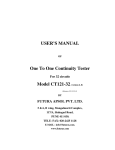
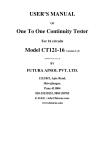
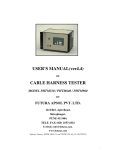
![User`s Manual [(ver2_0] Label Data Storage for Printing](http://vs1.manualzilla.com/store/data/005731436_1-9878257490003fe38f3b53735b78440c-150x150.png)
![User`s Manual [(LDSP_LCD_99_2)] Label Data](http://vs1.manualzilla.com/store/data/005846764_1-de86383eb41f3d06a08b51e5958ead91-150x150.png)
